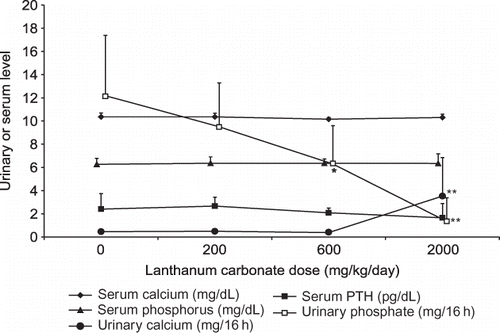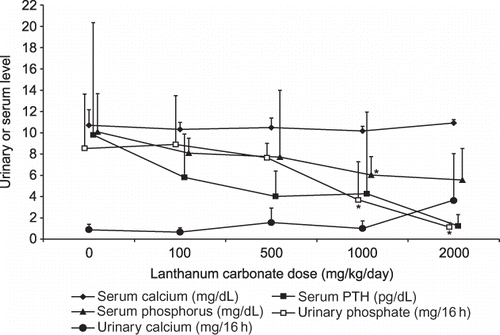Figures & data
Table 1. Assessment of the safety pharmacology of lanthanum carbonate
Figure 1. The effects of lanthanum carbonate and aluminum hydroxide on urinary (A) and fecal (B) excretion of [32P]-phosphate in rats with normal renal function. Rats (n = 5 per group) were treated with vehicle, lanthanum carbonate, or aluminum hydroxide by oral gavage for 12 days. On day 7, animals received a single oral dose of 11 µCi [32P]-phosphate. Urine and feces were then collected continuously for 144 h and sample radioactivity was determined. Data are mean ± SD.
Notes: *Denotes p < 0.05 versus lanthanum carbonate and aluminum hydroxide; NS, not significant.
![Figure 1. The effects of lanthanum carbonate and aluminum hydroxide on urinary (A) and fecal (B) excretion of [32P]-phosphate in rats with normal renal function. Rats (n = 5 per group) were treated with vehicle, lanthanum carbonate, or aluminum hydroxide by oral gavage for 12 days. On day 7, animals received a single oral dose of 11 µCi [32P]-phosphate. Urine and feces were then collected continuously for 144 h and sample radioactivity was determined. Data are mean ± SD.Notes: *Denotes p < 0.05 versus lanthanum carbonate and aluminum hydroxide; NS, not significant.](/cms/asset/0e287228-2354-4eeb-91ca-5cf326d28fd0/irnf_a_552821_f0001_b.gif)
Figure 2. Effect of lanthanum carbonate on phosphate, calcium, and parathyroid hormone (PTH) in rats with normal renal function. Rats (n = 10 per group) were dosed daily by oral gavage for 13 weeks with vehicle or lanthanum carbonate. Blood and urine samples were then collected during fasting conditions and phosphorus, calcium, and PTH levels were determined. Data are presented as mean ± SD.
Note: * and ** Denote p < 0.01 and p < 0.001, respectively, versus vehicle-treated control group.

Figure 3. Effect of lanthanum carbonate on phosphate, calcium, and parathyroid hormone (PTH) in rats with chronic renal failure. Rats (n = 10 per group) underwent 5/6th nephrectomy and were administered vehicle or lanthanum carbonate by oral gavage for 12 weeks. Blood and urine samples were then collected during fasting conditions and levels of phosphorus, calcium, and PTH were determined. Data are presented as mean ± SD.
Note: *Denotes p < 0.05 versus vehicle-treated control group.16

Figure 4. Relative urinary phosphate-lowering effect of lanthanum carbonate, aluminum hydroxide, calcium carbonate, and sevelamer hydrochloride in rats with chronic renal failure. Rats (n = 10) underwent 5/6th nephrectomy. Following stabilization postsurgery, animals were treated with vehicle or 1000 mg/kg/day of lanthanum carbonate, aluminum hydroxide, calcium carbonate, or sevelamer hydrochloride by oral gavage for 6 weeks. At weeks −3, 0, 2, 4, and 6, 24-h urine samples were collected and analyzed for phosphate levels. Data are presented as mean ± SD.
Source: Adapted from Hutchison.Citation7
Note: *Denotes p < 0.01 for least-squares (LS) mean change from baseline versus vehicle-treated control group.
